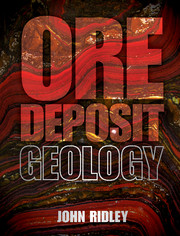Book contents
- Frontmatter
- Contents
- List of boxes
- Preface
- Acknowledgements
- 1 What is an ore deposit?
- 2 Magmatic ore deposits
- 3 Hydrothermal ore deposits I: magmatic and orogenic environments
- 4 Hydrothermal ore deposits II: sedimentary environments
- 5 Ore deposits formed in sedimentary environments
- 6 Supergene ores and supergene overprinting of ores
- Glossary
- References
- Index
- References
4 - Hydrothermal ore deposits II: sedimentary environments
- Frontmatter
- Contents
- List of boxes
- Preface
- Acknowledgements
- 1 What is an ore deposit?
- 2 Magmatic ore deposits
- 3 Hydrothermal ore deposits I: magmatic and orogenic environments
- 4 Hydrothermal ore deposits II: sedimentary environments
- 5 Ore deposits formed in sedimentary environments
- 6 Supergene ores and supergene overprinting of ores
- Glossary
- References
- Index
- References
Summary
Hydrothermal ore deposits in sedimentary basins are the dominant source worldwide of Pb, Zn, Co and U, and are significant sources of Ag and Cu. The major types of deposit are base-metal sulfide deposits and uranium deposits. Some of the types of uranium ore are not ‘hydrothermal’ based on the criterion that is commonly used to classify ore deposits in sedimentary basins – that the mineralising fluid was hotter than ambient temperatures. These ores are rather the result of groundwater flow at near-ambient conditions. They are, however, considered together with hydrothermal uranium ores because of the commonalities among the different deposit types.
The deposits in sedimentary basins are either syngenetic, and formed at the same time of sedimentation of the host-rocks, or epigenetic and formed up to hundreds of million years after sedimentation. Most of the host basins were not sites of magmatism over the times of mineralisation. Neither magmatic-hydrothermal fluids nor magmatic heat-driving fluid flow are thus considered to be factors in the formation of these ores. As will be discussed in this chapter, the metal-carrying solutions migrated distances of up to a few to hundreds of kilometres through the sedimentary rocks of the basin and in some cases also through underlying basement.
- Type
- Chapter
- Information
- Ore Deposit Geology , pp. 241 - 289Publisher: Cambridge University PressPrint publication year: 2013



